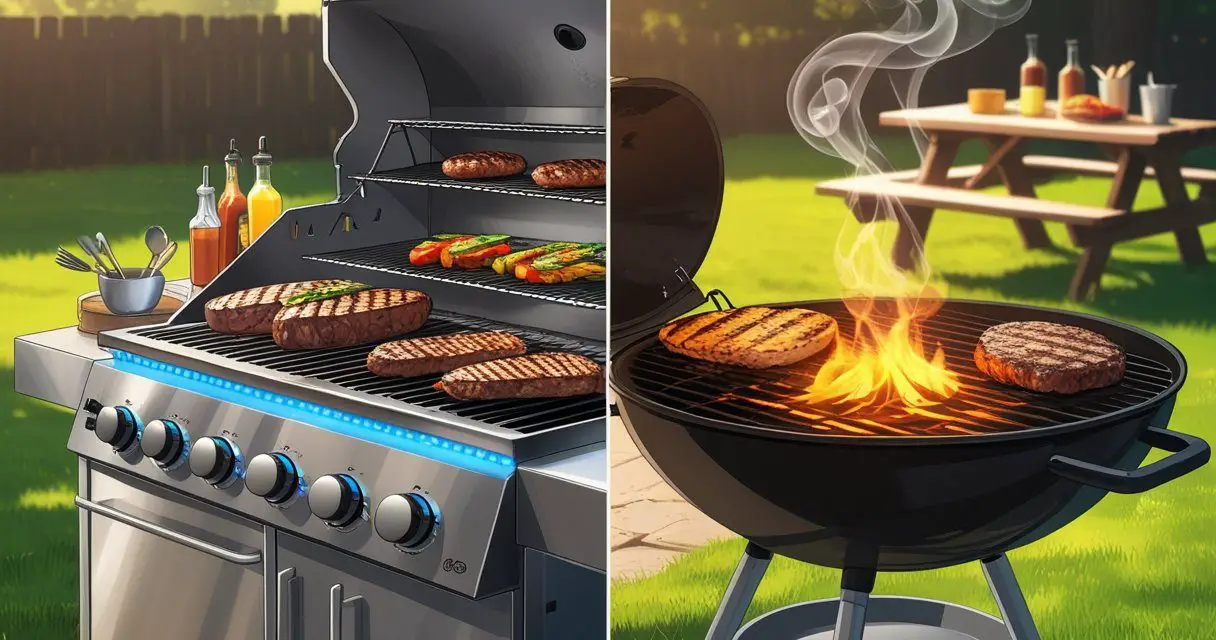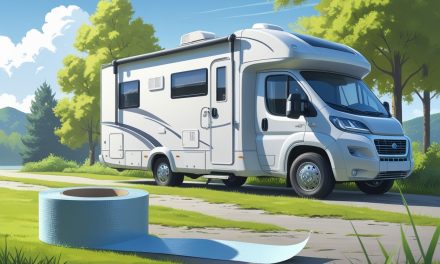Would you like to save this article?
You want to grill, but should you go with a gas or charcoal grill? There’s a lot of debate, and everyone seems to have a strong opinion. If you want fast and easy cooking, go with a gas grill, but if you want that smoky flavor, charcoal is the way to go.
You might prefer gas grills for convenience since they heat up quickly and are easy to control. Charcoal grills take longer and can get messy, but many people believe the flavor is worth it. Your choice depends on how you like to cook and eat.
Whether you grill every week or just a couple of times a year, picking the right type of grill makes a big difference in your experience. Keep reading to find out what sets gas and charcoal grills apart and which one will fit your backyard best.
What Is a Gas Grill?
A gas grill uses either propane or natural gas to cook food quickly and evenly. You get easy temperature control and faster preheating compared to other types of grills.
How Gas Grills Work
Gas grills work by using burners that heat up when you turn on the gas and ignite it. You connect the grill to a propane tank or a natural gas line, depending on what your grill supports. Burners are controlled with knobs that let you adjust the heat.
Most gas grills have a push-button or electronic ignition system. This system creates a small spark to light the burners safely and easily. Under the grilling surface, there’s usually a set of bars or metal plates. These help spread the heat and catch drippings from food, turning them into flavorful smoke.
You can cook at high or low heat just by turning the knobs. Gas grills also keep a steady temperature, which makes it simple to grill things like burgers, chicken, and steak. Cleanup is easier too since there’s little ash to deal with.
Types of Gas Grills
There are two main types of gas grills: propane grills and natural gas grills. Propane grills use a portable tank, which is simple to swap or refill. They are good if you like to move your grill around or don’t have a gas line at home.
Natural gas grills hook up directly to your house’s natural gas line. This means you won’t have to worry about running out of fuel in the middle of a cookout. But they are usually fixed in one spot and need installation.
There are also portable gas grills for picnics, tailgating, or camping. Tabletop models and freestanding options offer different sizes to match your space. Some high-end grills come with extra burners or even side burners for sauces.
Popular Gas Grill Features
Gas grills often come with handy features to make grilling easier and more fun. Many models have built-in thermometers so you can check the temperature without lifting the lid. Folding side shelves give you extra prep space.
Cast iron or stainless steel grates are common, and both are easy to clean. Some grills have side burners that let you heat sauces or side dishes at the same time as you grill.
Other features you might like include lights for nighttime grilling, warming racks for toasting buns, and built-in storage cabinets. Some grills have flavorizer bars or smoker boxes so you can add smoky taste to your food even when using gas.
Here’s a quick list of popular features:
- Electronic ignition
- Side burners
- Built-in thermometer
- Warming rack
- Storage cabinets
- Removable drip tray for easy cleaning
What Is a Charcoal Grill?
A charcoal grill cooks food by burning charcoal briquettes or lump charcoal for heat. You get a smoky, classic taste that’s different from grilling with gas. It’s popular for things like burgers, steaks, hot dogs, and veggies.
How Charcoal Grills Work
Charcoal grills use either briquettes or lump charcoal for fuel. You start by stacking and lighting the charcoal. Once the coals get hot and turn white-gray, you spread them out under the cooking grate. The heat from the burning charcoal cooks your food above.
When you grill with charcoal, you control the temperature by adjusting the airflow. Most grills come with vents at the top and bottom. Opening the vents lets more oxygen in, making the fire hotter. Closing them lowers the heat and helps cool things down.
You can set up different heat zones with more coals on one side for direct cooking and fewer on the other for indirect heat. Managing these zones takes practice, but it gives you flexibility for grilling different kinds of food.
Types of Charcoal Grills
Charcoal grills come in several main styles, each with its own strengths:
| Type | Description | Best For |
|---|---|---|
| Kettle Grills | Round, classic design; easy to use | Everyday grilling |
| Barrel Grills | Shaped like a barrel; large surface | Cooking for groups |
| Kamado Grills | Egg-shaped, thick walls for heat | Smoking and slow cooking |
| Portable Grills | Small, lightweight, easy to move | Camping, tailgating |
Kettle grills are the most common and are great if you’re just starting. Barrel grills are ideal for big gatherings. Kamado grills hold heat very well and can be used for both grilling and smoking food. Portable grills let you grill almost anywhere.
Key Charcoal Grill Characteristics
Charcoal grills are known for the smoky flavor they give your food. Cooking with charcoal takes more time than gas because you need to light the coals and wait for them to heat up. Temperature control is manual but flexible with proper vent use.
Charcoal grills can get hotter than most gas grills, which is good for searing meat. Cleaning up ash afterward takes extra work compared to a gas grill. Most charcoal grills are less expensive than gas models, but some specialty types like kamado grills can cost more.
You get more aroma and taste from the smoke, but mastering a charcoal grill takes practice. If you like hands-on cooking and don’t mind some cleanup, you may enjoy using a charcoal grill.
Flavor Differences Between Gas and Charcoal
When you grill with charcoal, the food cooks over real burning coals. This can give your food a smoky flavor that’s hard for gas grills to match.
Gas grills use propane or natural gas as fuel. They heat up quickly but don’t create much smoke. Because of this, the taste is often a bit milder and less smoky.
Some people say they can always tell when food is cooked over charcoal. Others think the difference is really small, especially for foods that cook fast, like burgers or hot dogs.
Here’s a quick look at how each grill affects flavor:
| Feature | Charcoal Grill | Gas Grill |
|---|---|---|
| Smoke Flavor | Strong | Mild |
| Burnt or Crisp Edges | More common | Less common |
| Quick Flavor Change | Yes, with wood chips | Harder to achieve |
With charcoal, you can add wood chips to boost the smoky flavor even more. Gas grills sometimes have smoker boxes, but it’s not quite the same.
If you like that backyard campfire taste, charcoal might be your pick. If you prefer a quick cook without much smoke, gas could work better for you.
Grilling Performance Comparison
Both gas and charcoal grills handle heat and cooking time differently. These differences can have a big impact on how your food turns out and how you use your grill day-to-day.
Heat Control and Temperature Range
With a gas grill, you get precise control right from the knob. You can turn the temperature up or down quickly, making it easy to adjust how fast or slow your food cooks. This is great when you’re juggling different types of food.
Charcoal grills take more effort to control the heat. You manage the temperature by moving coals, opening vents, or adding more fuel. It’s not as exact and can take some time to get used to. But charcoal can get hotter and is better for cooking steaks with a crisp crust.
Here’s a quick comparison:
| Feature | Gas Grill | Charcoal Grill |
|---|---|---|
| Heat Adjustment | Very Easy | More Difficult |
| Max Temperature | Usually Lower | Can Get Hotter |
| Heat Zones | Easy to Control | Harder to Control |
Cooking Speed
Gas grills heat up fast, sometimes in as little as 10 minutes. That means you can start cooking almost right away. This is handy if you don’t like waiting around or if you cook outdoors often during the week.
Charcoal grills take longer to get hot—usually 20 to 30 minutes for the coals to be ready. You also need to spend time spreading out the coals and waiting for them to reach the right temperature. This extra time adds up, especially if you only want to make a quick meal.
If you’re in a rush or cooking for a group, a gas grill saves time and effort. But if you like the process and flavor of slow, smoky grilling, charcoal might be more your style.
Ease of Use and Convenience
Using a grill should be simple and low-stress. How you start, maintain, and store fuel can make a big difference in your grilling experience.
Setup and Cleanup
With a gas grill, you just press a button or turn a knob to start. There’s no need to fiddle with lighter fluid or wait for coals to heat up. Setup takes less than five minutes, so you can get cooking fast after a busy day.
Cleaning is also quicker. Most gas grills only need a quick scrub of the grates. You can remove a grease tray and empty it without making a big mess.
Charcoal grills need more work. You have to arrange the coals, light them, and wait about 15-20 minutes for them to get hot. Cleanup involves dumping ash, and washing the grates can be messier. You’ll need to wear gloves and maybe get out a brush for stuck ash.
Fuel Storage and Availability
For gas grills, you use propane tanks or a natural gas connection. Propane tanks are heavy but easy to swap out when empty. Many stores sell them, and you can keep a spare. If you use natural gas, you never have to worry about running out, but you lose portability.
Charcoal comes in bags and is simple to store in a dry place. It’s light and doesn’t go bad, but you’ll need to buy fresh bags often if you grill a lot. You might run out faster than you expect, especially during long cooks or big gatherings.
Here’s a quick comparison:
| Gas Grill | Charcoal Grill | |
|---|---|---|
| Storage | Propane tank/natural gas line | Bags of charcoal |
| Availability | Easy to find, long-lasting | Easy to find, may use up faster |
| Portability | Good with propane, less with gas line | Very portable |
Cost Considerations
Both gas grills and charcoal grills come with their own set of costs. You’ll want to think about not just the price of the grill you buy but also what it costs to fuel and maintain it.
Grill Price Points
A charcoal grill will usually cost less than a gas grill when you look at the price tag. You can find a simple charcoal grill for around $50 to $100. Bigger or fancier charcoal models can go higher, but you don’t need to spend a lot to get started.
Gas grills often start at about $150 for a basic model. Mid-range gas grills typically cost between $250 and $600, but high-end models can easily be more than $1,000. Most of the extra cost comes from features like better burners, more space, and extra controls.
If you just want something cheap and basic, charcoal is the way to go. If you want convenience, more features, or more grilling space, you’ll likely pay more for a gas grill.
| Grill Type | Low-End Price | Mid-Range Price | High-End Price |
|---|---|---|---|
| Charcoal | $50–$100 | $100–$300 | $300+ |
| Gas | $150–$250 | $250–$600 | $1,000+ |
Fuel Costs Over Time
Charcoal can cost more over time because you need new charcoal every time you grill. A 15-pound bag of charcoal is usually about $10–$15 and may last for 3–5 grilling sessions, depending on how much you use. If you grill a lot, these costs add up quickly.
Propane gas comes in tanks that usually cost $15–$20 to refill. One tank can last for as many as 20 grilling sessions, depending on grill size and how long you cook each time. Natural gas grills cost less to run, but you need to have a natural gas hookup at your house.
Here’s a quick breakdown to compare:
- Charcoal: About $2–$5 per use
- Propane: About $1–$2 per use
You might spend more up front or over time, depending on how often you grill and which fuel you choose. If you grill a lot, gas will usually save you money in the long run. If you only grill sometimes or like the taste of charcoal, the extra cost might not matter as much.
Maintenance and Longevity
How you clean and care for your grill, plus the materials used, make a big difference in how long it lasts. Gas and charcoal grills each have their own needs when it comes to keeping them running well year after year.
Cleaning and Care
Gas grills are usually easier to clean. Grease trays, burners, and grates can just be removed and wiped down. You’ll need to check and clear out burner holes now and then to keep the flame working right.
Charcoal grills can get really messy with ashes and leftover char. After each use, you need to dump the ashes, scrub out the bowl, and brush the grates. If you don’t stay on top of it, the ash can hold in moisture and cause rust.
Both types need their grates brushed after every cook. It’s a good idea to cover your grill when you’re not using it. A cover prevents rust and keeps dirt, bugs, and bad weather from messing things up.
| Task | Gas Grills | Charcoal Grills |
|---|---|---|
| Ash removal | Not needed | After every cook |
| Grease management | Tray or cup | Usually less messy |
| Deep cleaning | Occasional, easier | Regular, messier |
Durability and Lifespan
Gas grills can last anywhere from 5 to 15 years. Stainless steel or cast aluminum bodies hold up better over time. The burners and ignition system are common points of failure, but you can replace them if needed.
Charcoal grills often last a long time if they’re cleaned and protected from the weather. The metal bowl or lid will rust if you let ash or moisture sit in it too long. Hinges and handles can wear out, but most parts are simple to fix.
The lifespan of any grill depends on how well you take care of it. Simple things like regular cleaning, covering it after use, and checking for rust will help keep your grill working for years.
Health and Safety Aspects
When picking between a gas grill and a charcoal grill, it’s not just about taste or ease of use. The kind of grill you choose can also affect your health and your safety while cooking.
Smoke and Emissions
Charcoal grills make more smoke than gas grills. This happens because when fat drips onto hot charcoal, it causes a lot of smoke and sometimes little bursts of flame. This smoke has chemicals called polycyclic aromatic hydrocarbons (PAHs) which can stick to your food.
These PAHs and the extra smoke can be unhealthy if you eat a lot of charcoal-cooked foods, especially if the meat gets really dark or burned. Gas grills burn cleaner and make less smoke, so there are fewer harmful chemicals soaked into your food. If you want to lower health risks when grilling, using a gas grill is usually safer in this way.
Fire Risks and Safety Precautions
With a charcoal grill, you need to handle hot coals, lighter fluid, and even ashes after you finish cooking. More open flames and sparks mean there’s a greater chance of starting an accidental fire. You’ll also have to wait for the coals to cool down safely before cleaning up.
Gas grills can be safer to start and stop, but they do have risks. Propane leaks or damaged hoses can be dangerous if you’re not careful. Always check the connections and look for gas leaks before lighting a gas grill. With either grill, keep a fire extinguisher nearby, and never leave your grill unattended while it’s hot. Here’s a quick list of safety steps for both:
- Always grill outside in an open area
- Keep children and pets away
- Don’t leave a hot grill alone
- Check for gas leaks
- Dispose of ashes in a metal container
Paying attention to these steps helps keep your cooking safe.
Environmental Impact
When it comes to grilling, both gas and charcoal have an effect on the environment. If you care about your carbon footprint, it’s good to know how each type stacks up.
Charcoal grills burn wood or briquettes. This process lets off a lot of carbon dioxide (CO2) and small particles into the air. Some sources say charcoal gives off about twice as much CO2 as gas for the same amount of grilling.
Gas grills use propane or natural gas. These fuels still create CO2, but much less compared to charcoal. Gas grills also start up faster, so you use less energy just getting your grill hot.
Here’s a quick comparison:
| Type | Main Fuel | CO2 Emissions | Start Time |
|---|---|---|---|
| Charcoal | Wood or briquettes | High | Longer |
| Gas | Propane/natural gas | Lower | Shorter |
Key points to remember:
- Charcoal creates more pollution.
- Gas grills are more energy efficient.
- Lighting charcoal may require lighter fluid, adding more emissions.
If you want to reduce your impact, choosing a gas grill is the greener choice. You can also look for lump charcoal made from sustainable wood if you prefer the taste of charcoal.
Which Grill Is Better for You?
Choosing between a gas grill and a charcoal grill comes down to your lifestyle and what you value most in grilling.
Gas grills are best if you want quick and easy grilling. They heat up fast and are simple to control. You can start cooking with the push of a button, so they’re great if you grill often or during busy weeknights.
Charcoal grills take more time to get started, but they give a smokier flavor that some people love. If you enjoy the smell and taste of charcoal and don’t mind waiting a bit longer, you might like this style better.
Here’s a quick comparison:
| Feature | Gas Grill | Charcoal Grill |
|---|---|---|
| Setup Time | Fast | Slower |
| Flavor | Mild | Smoky |
| Cleanup | Easier | Messier |
| Cost | Usually higher | Usually lower |
| Temperature Control | Very easy | Takes practice |
Ask yourself a few questions:
- Do you want to grill several times a week without much fuss?
- Do you prefer strong smoky flavors, or is convenience more important?
- Are you okay with a little extra cleanup for a richer food taste?
Your answers will help you figure out which grill fits your needs.
Final Thoughts on Gas Grills vs Charcoal Grills
Choosing between gas and charcoal grills depends on what you want out of your grilling experience.
If you want quick cooking and easy cleanup, a gas grill can save you time. You can start it with just a push of a button, and it heats up fast.
Charcoal grills take longer to get started and need more clean-up. But they give your food that classic, smoky flavor. Many people say this taste is hard to beat.
Here’s a simple table to compare:
| Feature | Gas Grill | Charcoal Grill |
|---|---|---|
| Startup Time | Fast | Slow |
| Flavor | Milder | Smokier |
| Cleanup | Easier | Messier |
| Cost | Usually higher upfront | Usually lower upfront |
| Convenience | High | Lower |
If you want more convenience, go with gas. If tasty, smoky flavor is your main goal, charcoal is a solid pick.
Think about your budget, how much time you want to spend, and how important flavor is to you. Your choice depends on what matches your needs the most.
Both grills can help you cook great food. The best grill for you is the one that fits your style.






